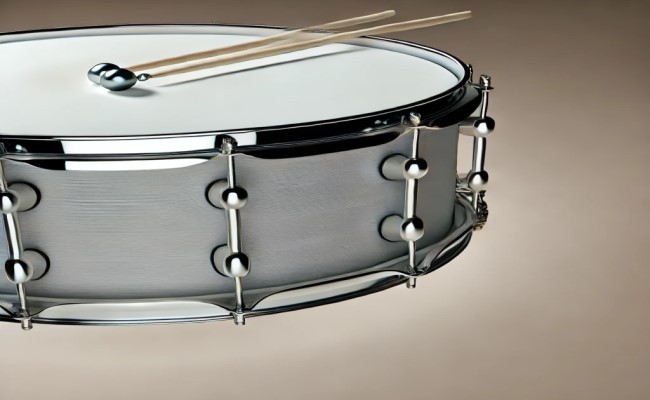Instrument That Goes Rat A Tat Tat: The Versatile Snare Drum
Unveiling the Magic Behind the Iconic Sound

The “instrument that goes rat a tat tat,” widely known as the snare drum, is a fundamental component in various music genres. Its distinctive, sharp, staccato sound is achieved through a combination of drumsticks striking the drumhead and the unique construction of the drum itself, which includes snares made of metal wires or plastic strands stretched across the bottom of the drum. This article explores the snare drum’s history, mechanics, and significance in traditional and contemporary music.
The Historical Significance of the Snare Drum
Origins and Evolution
The snare drum has a rich history that dates back to medieval Europe. Initially used in military settings to communicate commands and boost morale, it evolved over centuries to become a staple in orchestras, marching bands, and modern drum kits. Its journey from the battlefield to the concert hall illustrates its adaptability and enduring appeal.
Military Roots and Early Uses
In medieval Europe, the snare drum, known as the tabor, was primarily used in military contexts. It provided rhythmic patterns that soldiers could march to and conveyed commands during battles. The drum’s portability and powerful sound made it ideal for these purposes.
The Mechanics of the Snare Drum
Construction and Design
The snare drum’s distinctive sound results from its unique construction. It consists of a shell, usually wood or metal, and a top and bottom drumhead. The snares, a set of metal wires or synthetic strands, are stretched across the bottom drumhead, creating a crisp, rattling sound when the top drumhead is struck.
How It Works
When a drummer strikes the top drumhead, vibrations travel through the drum, causing the snares to rattle against the bottom drumhead. This interaction produces the snare drum’s characteristic “rat-a-tat-tat” sound. The tension of the drumheads and snares can be adjusted to achieve different tones and responses, allowing for a wide range of sounds.
The Snare Drum in Modern Music
Role in Different Music Genres
The snare drum plays a crucial role in various music genres, from classical and jazz to rock and hip-hop. Its versatility allows it to produce a wide range of sounds, from delicate rolls to powerful accents, making it an indispensable part of any drum kit.
Iconic Performances and Artists
Throughout music history, many drummers have showcased the snare drum’s capabilities. Legendary drummers like Buddy Rich, Neil Peart, and John Bonham have used the snare drum to create memorable rhythms and solos, highlighting its potential as a rhythmic and melodic instrument.
Mastering the Snare Drum
Techniques and Skills
Mastering the snare drum requires a combination of technical skill and musicality. To fully utilize the instrument’s capabilities, drummers must learn various techniques, such as rollinstrument’sd paradiddles. Consistent practice and a solid understanding of rhythm are essential for developing proficiency.
Importance of Practice
Practicing with a metronome and participating in drumline or ensemble settings can significantly improve a drummer’s timing and precision. Focusing on developing hand speed, control, and coordination will help drummers efficiently execute complex rhythms and dynamic changes.
The Snare Drum in Popular Culture
Its Presence in Media and Entertainment
The snare drum’s iconic sound is not limited to music; it also appears frequently in films, television, and commercials. Its sharp, attention-grabbing tone often builds tension or punctuates dramatic moments, underscoring its cultural significance beyond the music world.
Famous Snare Drum Solos
Many famous songs feature snare drum solos or prominent snare parts that have become instantly recognizable. For example, the opening drum roll in Led Zeppelin’s “Rock and Roll“ and the intricate snare work in Metallica’s “One“ demonstrate the instrument’s versatility and impact.
Choosing the Right Snare Drum
Factors to Consider
When selecting a snare drum, drummers should consider factors such as the material of the shell, the type of drumheads, and the design of the snares. Each of these elements can significantly influence the sound and performance of the drum.
Popular Brands and Models
Several reputable brands, including Ludwig, Pearl, and Yamaha, offer high-quality snare drums. Each brand has unique characteristics and specialties, catering to different playing styles and preferences. Exploring various models and experimenting with different setups can help drummers find the perfect snare drum for their needs.
Conclusion
The snare drum, known for its distinctive “rat-a-tat-tat“ sound, is a versatile and essential instrument in the music world. From its historical roots in military settings to its prominent role in modern music, the snare drum continues to captivate audiences and inspire musicians. Whether used in a marching band, an orchestra, or a rock concert, its unique sound and dynamic range make it a cornerstone of percussion. Aspiring drummers should invest time in mastering this instrument, as its impact on music and culture is undeniable.

